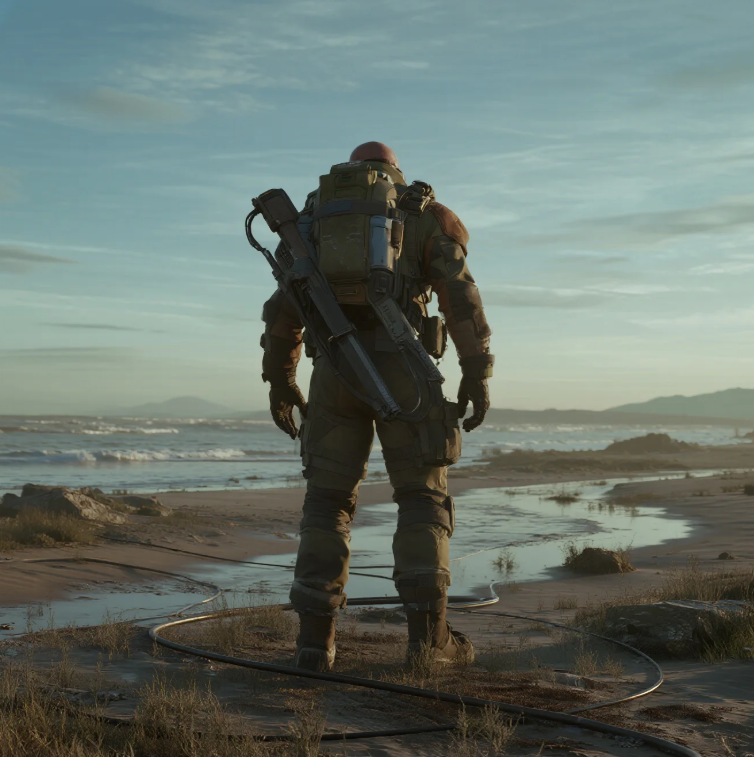The arrival of Death Stranding 2: On the Beach this year has sparked a wave of excitement and hope among gamers and critics alike. Unlike many blockbuster sequels that lean heavily into spectacle or sheer action, this latest installment carries a unique message that resonates deeply in today’s world — a message of connection, resilience, and optimism that feels both timely and profound. It’s rare for a game to combine cutting-edge graphics, immersive gameplay, and such an emotionally rich narrative in a way that truly captivates the spirit, and Death Stranding 2 manages to do just that.
The original Death Stranding was known for its cinematic quality, with stunning landscapes, a hauntingly beautiful score, and a storyline that challenged players to rethink the meaning of human connection. On the Beach continues this legacy but with a softer, more hopeful tone. The game’s thematic focus shifts subtly from isolation to community, from survival to thriving together. This shift feels especially powerful in a world still grappling with social distancing and digital isolation. The developers took immense care in designing environments that feel alive and welcoming rather than desolate and foreboding. The beaches, once symbols of loneliness and danger, now glow with the warmth of sunrise, inviting players into a journey of renewal.
When you first step into the game, it’s impossible not to notice the meticulous detail in the world-building. Every grain of sand, every crashing wave, and every gust of wind works in harmony to immerse you fully. The enhanced photorealistic graphics, powered by the latest game engines, create a visceral experience that makes you feel as though you’re truly standing on those shores. High-CPC keywords like photorealistic gaming, open world adventure, and next-gen graphics come to mind as one marvels at the painstaking attention to detail.
What sets Death Stranding 2 apart, however, is how it uses gameplay mechanics to reinforce its central themes. The iconic delivery missions return, but this time they’re imbued with new layers of meaning. Instead of mere logistical challenges, these missions represent acts of kindness, trust, and rebuilding relationships in a fractured world. Players find themselves not just traversing landscapes but weaving threads of connection that bring communities together. The game encourages collaboration — sometimes through direct multiplayer interactions and other times through more subtle, asynchronous support systems that allow players to aid one another in unexpected ways.
In everyday life, moments of connection can seem small but are no less significant. The game’s narrative cleverly mirrors this by focusing on characters’ stories — their hopes, fears, and dreams — that unfold gradually through poignant cutscenes and interactive dialogue. The protagonist’s journey is one of healing, not just physical but emotional, reminding players of the importance of empathy and compassion. The developers’ choice to emphasize emotional storytelling, character-driven narratives, and immersive gameplay experiences aligns perfectly with what many modern gamers seek: more than entertainment, a meaningful experience.
The soundtrack deserves special mention as well. Music plays a critical role in enhancing the emotional landscape, blending haunting melodies with uplifting harmonies. It’s a perfect accompaniment to the visuals and storytelling, creating a holistic sensory experience. Terms like game soundtrack composition and immersive audio design are highly relevant here, underscoring the artistry involved. Listening to the music while exploring the vast beaches can evoke a sense of peace and introspection, turning gameplay into a meditative experience.
Throughout my time with the game, I noticed how players often shared their experiences online — not just their achievements, but the emotions the game stirred within them. Stories emerged of players who found solace in the virtual world during stressful times, who connected with others through shared goals, or who were moved by the narrative’s hopeful message. This phenomenon highlights a growing trend in gaming: the desire for therapeutic gaming experiences and social connectivity through video games. It’s a reminder that beyond the pixels and mechanics, games can touch the heart and soul.
The accessibility of Death Stranding 2 also deserves praise. The developers made sure that the game welcomes both hardcore fans of the original and newcomers alike. Intuitive controls, comprehensive tutorials, and scalable difficulty options mean that a wide range of players can enjoy the experience without feeling overwhelmed. This thoughtful design strategy speaks to the growing importance of inclusive game design and user-friendly gameplay in the industry.
Moreover, the game’s environmental themes resonate strongly today. The beaches and natural landscapes are more than just beautiful backdrops; they serve as metaphors for sustainability and our relationship with nature. The narrative gently nudges players to reflect on ecological stewardship, a topic that is becoming increasingly vital in entertainment media. Keywords like eco-conscious gaming and environmental storytelling reflect the game’s commitment to these contemporary concerns.
In addition to its technical and thematic strengths, Death Stranding 2 shines through the subtle ways it challenges players’ perspectives. It asks us to reconsider what it means to be isolated and how connection can be rebuilt, even in the face of overwhelming obstacles. This resonates on a personal level as well, making it more than just a game but a cultural touchstone. The optimistic tone, combined with its ambitious scope, ensures that it will be remembered as one of the most hopeful blockbusters of the year.
While the action-packed sequences and breathtaking visuals draw attention initially, it’s the game’s heart — the relationships it nurtures and the hope it inspires — that lingers long after the console powers down. The experience leaves you contemplating your own connections and the world around you, which is a rare achievement for any entertainment medium.

In the ever-evolving landscape of video games, Death Stranding 2: On the Beach stands out not only for its innovation and artistry but also for its message of hope and togetherness. It reminds us that even in uncertain times, stories have the power to heal, unite, and inspire. As players continue to explore its beaches and build bridges, they’re not just playing a game — they’re participating in a shared journey toward a brighter future 🌅
